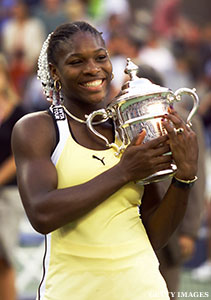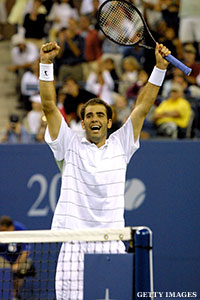
Serena Williams received the No. 28 seed for the U.S Open, which triggered controversy as Williams, her fans and the media disapproved of such a low seed for the three-time champion.
But does the seed really matter? Williams has already won a Grand Slam -- the 2007 Australian Open -- as an unseeded player. She was ranked 81st in the world before that tournament after being inactive the previous two years.
Her current world ranking is No. 29. If Williams truly is the top player in the world, as she believes, she should be able to win seven matches against whichever opponents are thrown at her. She'll have the crowd behind her the entire way (although maybe not the umpires). Her draw could not have been better, as she randomly drew No. 4 Victoria Azarenka as the top-four seed in her quarter of the bracket. If she reaches the fourth round, she will likely face No. 16 Ana Ivanovic, who is not nearly the player she once was. Even as the No. 28 seed, Williams is still the clear favorite to get out of her eighth of the bracket.
Here are a look at low-seeded and unseeded player who won the U.S. Open or made it to the finals. (The U.S. Open expanded its seeding system from 16 to 32 in 2001.)
Andre Agassi, unseeded, 1994
In late 1993, America’s darling son hit rock bottom. Agassi, the 1990 U.S. Open runner-up, lost in the first round and needed wrist surgery weeks later. For most of 1994 season, Agassi could not recapture his Top-20 mojo, losing in the second and fourth rounds at the French Open and Wimbledon, respectively.
At the U.S. Open, new coach Brad Gilbert hammered the concept of consistency into Agassi’s head, and the 24-year-old Agassi brought the heat early, dropping only one set in his first three matches. The New York crowd again fell in love with his bubbly personality and blond mullet (which we now know was a wig) and saw history in the making. After upsetting No. 12 seed Wayne Ferreira in the third round, Agassi pulled off a five-set thrilling victory over No. 6 Michael Chang in the fourth round. In his final three matches, Agassi knocked off Thomas Muster, Todd Martin, and Michael Stich, seeded No. 13, No. 9 and No. 4, respectively. He is still the only man to ever win the U.S. Open as an unseeded player.
Kim Clijsters, unseeded, 2009
 In May 2007, just before her 24th birthday, Kim Clijsters retired, citing multiple injuries. She had five Grand Slam titles and was ready to start a family with her husband, Brian Lynch, a former Villanova basketball star. They married in July 2007 and gave birth to a daughter in February 2008. Clijsters began the life of a stay-at-home-mom. That was, until January 2009, when Clijsters was asked to play in a mixed doubles exhibition in May with Tim Henman, Steffi Graf and Andre Agassi at Wimbledon’s Centre Court to debut the court's new roof. While preparing for the exhibition, Clijsters recaptured her love of tennis and applied for wild card entries into two U.S. Open Series events and the U.S. Open.
In May 2007, just before her 24th birthday, Kim Clijsters retired, citing multiple injuries. She had five Grand Slam titles and was ready to start a family with her husband, Brian Lynch, a former Villanova basketball star. They married in July 2007 and gave birth to a daughter in February 2008. Clijsters began the life of a stay-at-home-mom. That was, until January 2009, when Clijsters was asked to play in a mixed doubles exhibition in May with Tim Henman, Steffi Graf and Andre Agassi at Wimbledon’s Centre Court to debut the court's new roof. While preparing for the exhibition, Clijsters recaptured her love of tennis and applied for wild card entries into two U.S. Open Series events and the U.S. Open.
In the first two events in Cincinnati and Toronto, Clijsters lost before the semifinals. But with a WC next to her name on the draw sheet, Kimpossible dropped just one set in her first three matches. In the fourth round, she slipped past No. 3 Venus Williams 6-0, 0-6, 6-4. In the quarterfinals, Clijsters edged Li Na before upsetting defending champion Serena Williams in straight sets in the semifinals (although Serena will tell you it was the baseline judge's fault). In the final, Clijsters beat No. 9 Caroline Wozniacki, who was seven years younger than her, to become the only wild card, man or woman, to ever win the U.S. Open.
Pete Sampras, No. 17, 2002
 In 2002, the Pete Sampras farewell tour reached Flushing Meadows. The 31-year-old's career was on the decline, as he had lost in the first and second rounds at French Open and Wimbledon. Many speculated that Sampras, who had not been seeded as low as No. 17 at the U.S. Open since he was unseeded in 1989, was playing for the final time in Flushing. Pete wanted to go out with a bang. He won his first two matches in straight sets before meeting veteran Brit and former finalist Greg Rusedski in a rare night match at Louis Armstrong Stadium. The day session fans filed into the side court to watch Sampras pull out a wild five-set victory. In his post-match press conference, Rusedski claimed that Sampras was "a step and a half slower" and guaranteed that he would lose his next match. Rusedski's bloody prediction only fueled the intensity of Sampras and the New York crowd, as Pete defeated No. 3 Tommy Haas in the fourth round.
In 2002, the Pete Sampras farewell tour reached Flushing Meadows. The 31-year-old's career was on the decline, as he had lost in the first and second rounds at French Open and Wimbledon. Many speculated that Sampras, who had not been seeded as low as No. 17 at the U.S. Open since he was unseeded in 1989, was playing for the final time in Flushing. Pete wanted to go out with a bang. He won his first two matches in straight sets before meeting veteran Brit and former finalist Greg Rusedski in a rare night match at Louis Armstrong Stadium. The day session fans filed into the side court to watch Sampras pull out a wild five-set victory. In his post-match press conference, Rusedski claimed that Sampras was "a step and a half slower" and guaranteed that he would lose his next match. Rusedski's bloody prediction only fueled the intensity of Sampras and the New York crowd, as Pete defeated No. 3 Tommy Haas in the fourth round.
Huffing and puffing his way through what would be his final ATP Tour event, Sampras beat upstart American No. 11 Andy Roddick in the quarterfinals and No. 24 Sjeng Schalken in the semifinals. In the finals, Sampras played Andre Agassi for the final time as a professional, winning in four sets to claim his fifth U.S. Open title. Sampras never played another ATP Tour match again and formally announced his retirement at the 2003 U.S. Open.
Venus Williams, unseeded, 1997
Serena's big sister was 17 when she arrived in Flushing for her first U.S. Open. Ranked 66th in the world, Williams lost her first set of the tournament, but did not lose another until the semifinals. She had a big win against No. 8 Anke Huber. In the semifinal match against No. 11 Irina Spirlea, Williams needed a third set tiebreak to reach the finals. In the championship match, No. 1 Martina Hingis denied Williams of her first Grand Slam title.
Mary Pierce, No. 12, 2005
In 2005, 30-year-old Mary Pierce was a hard court afterthought. She had won her only hard court Grand Slam at the Australian Open in 1995 and had not made it to the quarterfinals in Flushing since 1999. But Pierce gained momentum for the final hurrah of her career. She knocked off No. 17 Jelena Jankovic in the third round and No. 7 Justin Henin-Hardenne in the fourth round. Pierce continued the upset train with defeats of No. 3 Amelie Mauresmo and No. 6 Elena Dementieva in the quarterfinals and semifinals. Her magical New York City run ended, though, in the finals, at the hands of Kim Clijsters.
Serena Williams, No. 7, 1999
When the 1999 U.S. Open started in late August, no woman outside of the top six seeds had ever won the singles tournament. It was Serena Williams (yes, the subject of this article), who became the lowest-seeded woman of the time to ever win the tournament (2004's No. 9 seed Svetlana Kuznetsova and Clijsters have since surpassed that record). Along the way, she defeated 16-year-old Kim Clijsters, No. 16 Conchita Martinez, No. 4 Monica Seles, No. 2 Lindsay Davenport, and in the championship, No. 1 Martina Hingis, to take home the title.




